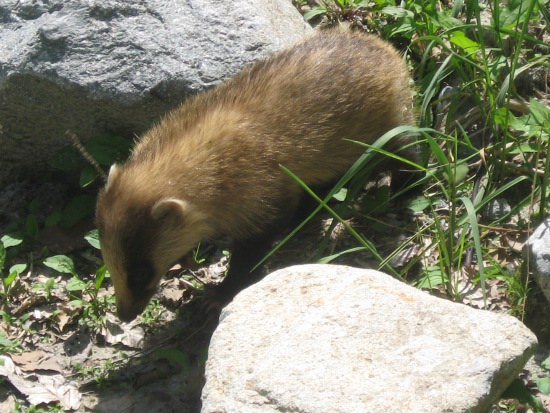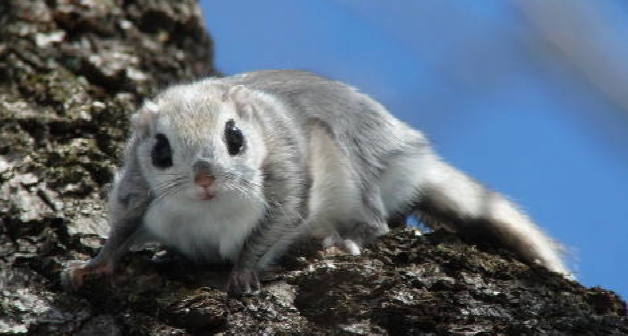A Mammal Watcher's Guide to Japan
 More than 131 non-marine and 43 marine mammals species have been recorded so far in Japan, giving Japan a surprising total of 174 species (five of which are recently extinct). This mammal fauna is disproportionately biased, such that the prefecture with most species is the northernmost one of Hokkaido (conversely the southernmost prefecture, Okinawa, has relatively few mammals, but the highest number of reptile species).
More than 131 non-marine and 43 marine mammals species have been recorded so far in Japan, giving Japan a surprising total of 174 species (five of which are recently extinct). This mammal fauna is disproportionately biased, such that the prefecture with most species is the northernmost one of Hokkaido (conversely the southernmost prefecture, Okinawa, has relatively few mammals, but the highest number of reptile species).
Japan's mammal fauna consists of various elements:
- Wide-ranging Holarctic species, such as the Red Fox and Brown Bear, in common with northern North America and the great span of northern Eurasia.
- Palaearctic species, such as the Eurasian Red Squirrel and Siberian Flying Squirrel, which range from Scandinavia to Hokkaido.
- East Asian species, known from Japan and adjacent areas, such as the Tanuki (Raccoon Dog) and the Japanese (Sika) Deer.
- Endemic Japanese species ranging widely throughout several of the main Japanese islands, such as the Japanese Macaque.
- Endemic Japanese species occurring only in isolated localities, particularly on offshore islands, such as the Amami Rabbit.
- Recently extinct species (5), such as the River Otter and Japanese Wolf.
- Introduced/Alien species, such as Pallas’s Squirrel and North American Raccoon.
- Marine species ranging from the sub-tropical waters off the southernmost islands, the warm seas around southern Japan, the cold current flowing south down the Pacific coast and the frigid waters of the southern Okhotsk Sea.
These species include extremely diverse species belonging to the cetacea, sirenia, insectivora, chiroptera, primates, carnivora, artiodactyla, rodentia, and lagomorpha, and more than 40 of these mammal species are endemic just to the Japanese islands.
Regional variation in the Japanese Mammal Fauna
The islands of the Japanese Archipelago span two major zoogeographic regions: the Palaearctic and the Oriental regions. Northern Japan, that is Hokkaido and the three main islands to its south known as Hondo (Honshu, Shikoku and Kyushu), fall within the Palaearctic Region, while southern Japan, the southwestern islands lying south of the Tokara Strait, belongs to the Oriental Region. The distinctions between these two provide an indication as to the main origins of their faunas. Thus the northern region of Japan supports mammals mainly of temperate and sub-arctic origin, while the southern region of Japan supports mammals originating in the sub-tropical and tropical area.
Looking more closely, if we consider only northern Japan, lying in the Palaearctic Region, and look only at terrestrial mammals, we recognise three readily identifiable groupings. First, there is Hokkaido, in the north, then Hondo (Honshu, Shikoku and Kyushu), and third there are the Tsushima Islands (lying between Kyushu and the Korean Peninsula). Hokkaido shares nearly half of its mammal fauna with regions further to the north in Russia, particularly Sakhalin and the Russian Far East, indicating Hokkaido’s past connection to the East Asian part of the Eurasian Continent via land bridges to the north. The land bridge connecting Hokkaido, via Sakhalin to northeast Russia is thought to have endured for some 60,000 years or so during the last glacial period allowing species such as the Northern Pika and Mountain Hare to occupy lands as far south as Hokkaido. Hokkaido also shares just over half of its mammal fauna with Hondo, but the much deeper Tsugaru Strait remained open during most of the last glacial period denying access towards the south to many northern species.
Looking to Hondo now, approximately 50% of the non-marine mammals found there are endemic and some of these belong to the oldest elements of the Japanese mammal fauna. The mammalian fauna of Hondo falls into two groups, depending on their relationships with the mammals of other parts of East Asia. One group shows links to the north with relatives found on the Korean Peninsula, in northern China and regions further north, while the other group shows relationships with species inhabiting more southerly regions of Asia.
When we consider Tsushima, the small group of islands lying in the strait between the Korean Peninsula and Kyushu, it is unsurprising that it shares species in common with both Hondo and the continent. In fact some continental species occur in Japan only on those islands. The islands can be seen then as a bio-geographical transitional zone between Hondo and the continent.
If we consider the southwestern islands of Japan, variously called The Ryukyu Islands, and the Nansei Shoto, those islands lying south of the Tokara Strait, but north of Taiwan, we find a particularly fascinating fauna. These islands lie within, or at least straddle the ill-defined border of, the Oriental Region. Although repeated connections and separations between the islands and the continent to the south have occurred the islands themselves have remained isolated sufficiently long (either as a connected ridge, or as further isolated islands) for local endemic species to have evolved. More than 50% of the native non-marine mammals of this area are endemic and some of them not just at the specific level, but also at the generic level.
It is this considerable diversity, within the relatively small land area of Japan (approximately the same size as Germany, or slightly larger than New Zealand or the British Isles) that makes the mammalian fauna of Japan such an interesting one.
Conservation Issues
The unique mammal fauna of Japan faces particular issues in this partly over-crowded nation. Unlike in many other countries these issues do not include hunting for sport (an uncommon and declining past-time), nor is there a bush-meat trade driving populations down. However, habitat loss is a critical issue. The lowlands of the Japanese islands are intensely developed for agriculture, industry and urbanisation thus few areas of natural lowland habitat survive. The mountainous areas are less developed or disturbed providing more plentiful habitat for species able to survive at higher elevations, however even here habitat loss, or degradation, are issues to consider. More recently, and compounding the issue of habitat loss, the introduction of alien species is causing difficulties for native species. Alien species, whether introduced deliberately, or accidentally, occupy important ecological niches in a previously natural ecosystem; they may become predators of native species (mammals or otherwise), or they may compete with them for valuable resources such as food, cavities, den sites and so on. The introduction of alien species has far-reaching implications for the native mammal fauna and deserves considerable attention from the conservation community.
 Guide to the Mammals of Japan
Guide to the Mammals of Japan
A significant proportion of the mammals of Japan are either rodents or bats; both groups are particularly difficult to photograph or identify in the field. No field guide to Japanese mammals has attempted to include all terrestrial, flying and marine mammals in one volume so my aim here, is to cover as broad a range of the larger species occurring in the region as possible.
Submissions
If you have photographic or other illustrative material of species not currently included here and would be interested in submitting it, please write to Japan Nature Guides for submission guidelines.

